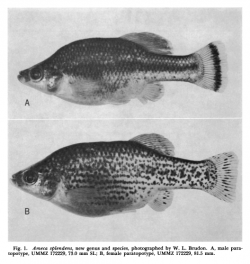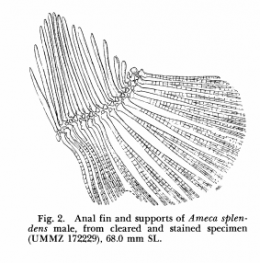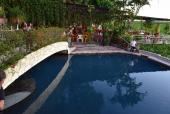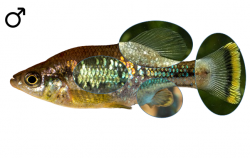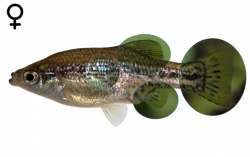Ameca splendens
MILLER, R. R. & J. M. FITZSIMONS (1971): Ameca splendens, a new Genus and Species of Goodeid Fish from Western México, with Remarks on the Classification of the Goodeidae. Copeia, 1971, No. 1: pp 1-13
Collection-number: University of Michigan Museum and Zoology, Cat. No. UMMZ-172227.
The Holotype is an adult male of 60.5mm standard length, collected by R. R. Miller and J. T. Greenbank on March the 25th, 1955. It was collected with a female Allotype of 64mm standard length (Cat. No. UMMZ-172228) and 198 Paratopotypes of standard lenghts between 17 and 90mm (Cat. No. UMMZ-172229).
Miller and Greenbank collected this species in the Río Teuchitlán just below the small town of Teuchitlán, near the road between HW 70 (Ameca to Guadalajara) and Etzatlán, about 75km W of Guadalajara, federal state of Jalisco.
The name is derived from the Latin. It is the inflected form of the verb "splendere" which means "to shine", so splendens has the denotation of "bright", "shining" or "glowing". This epithet was chosen in reference to the "striking life colours of the new species" (Miller, 1971).
The genus was named by R. R. Miller and J. M. Fitzsimons in 1971 after the river "to which the new genus is eventually confined." The name of the Ameca river again, but also of the town with the same name, is from Nahuatl origin, the language of the Aztec people, with "amecatl" meaning string of water.
none
The Butterfly Splitfin is endemic to the Mexican federal state of Jalisco. It is historically known from the Río Teuchitlán, a tributary of the Río Ameca, from some springs along the NNE shore of the Presa La Vega (the dammed Río Teuchitlán below the town of Teuchitlán), from the Arroyo Los Lobos E of Teuchitlán (an affluent of the Río Teuchitlán), from the Río Ameca itself E of the town of Ameca, from the Balneario Almoloya near La Estancia de Ayones (endorheic Laguna Magdalena basin) about 35km NW of Teuchitlán, and from several springs and the El Molino pond near Cuyacapán, endorheic Laguna de Sayula basin, about 95km SSE of Teuchitlán. The species disappeared from the Sayula lagoon habitats probably around 2010 due to extensive groundwater pumping, draining all these springs, and furthermore only persisted in the Balneario Almoloya and several Río Teuchitlán springs. Affiliated to three distinct drainages, three subpopulations can be inferred: The Río Ameca subpopulation (type subpopulation), the Laguna Magdalena subpopulation and the Laguna de Sayula subpopulation. The last one disappeared from the wild a few years after it had been discovered and is regarded Extinct. The bold names are the ones officially used by the Instituto Nacional de Estadística y Geografía; nevertheless, other ones might be more often in use or better known and therefore prefered.
ESU ist short for Evolutionarily Significant Unit. Each unit expresses an isolated population with different genetic characteristics within one species. ESU's can be defined by Molecular genetics, Morphology and/or Zoogeography and help in indicating different phylogenetic lineages within a species. The abbreviation for an ESU is composed of three letters of the genus, followed by the first two letters of the species name and an ongoing number in each species.
In Ameca splendens, we are not able to distinguish different ESU's, so all fish belong to Amesp1.
The left map shows the Lago de Chapala (CH) and the Río Santiago-Aguamilpa (SA) basins from the Hydrographic Region Lerma-Santiago, and the Presa La Vega-Cocula (VC) basin from the Hydrographic Region Ameca on a Mexico map. The right map shows, where the Butterfly Splitfin was originally known from: both subbasins of the Presa La Vega-Cocula basin, namely the ríos Salado (SAL) and Cocula (COC) subbasins, the Laguna de Sayula subbasin (SAY), Lago de Chapala basin, and the Laguna Magdalena-Laguna Palo Verde subbasin (MPV), Río Santiago-Aguamilpa basin. The species became probably extirpated from the Laguna de Sayula subbasin and from the lower sections of the Upper Río Ameca drainage, but is still present within the other two subbasins. A historical occurence in the endorheic Laguna de San Marcos subbasin sounds possible as this subbasin was once connected with the Upper the Río Ameca and the Laguna de Sayula, but as this occurence is not documented by vouchers and a different distribution event to reach the Laguna de Sayula subbasin might have been also possible, it is not considered on the map:
International Union for Conservation of Nature (IUCN): Critically Endangered
Distribution and current conservation status of the Mexican Goodeidae (Lyons et al., 2019): Endangered/declining: „This species is known from the Teuchitlán Springs and was recently discovered in the Almoloya Springs in the endorheic Lake Magdalena basin and the El Molino Springs in the endorheic Lake Sayula basin, both close to but separate from the Ameca basin. No genetic or morphological analyses of the three populations are available, but we consider each to be a separate ESU based on zoogeography. Amesp1 is endangered and occupies the Teuchitlán Springs and its outlet the Teuchitlán River. Historically, the population extended well down the river to its junction with the Salado River to form the Ameca River. However, it is now limited to the upper part of the Teuchitlán Springs and two small tributary springs that enter the river 2–3 km downstream. The Teuchitlán Springs population probably numbers in the high hundreds or low thousands and appears to be stable (López-López et al., 2004), but the two smaller springs have not been thoroughly assessed. Bailey et al. (2007) provided a detailed analysis of genetic diversity within the Teuchitlán Springs population. Amesp2 is critically endangered and known only from the Almoloya Springs in the Magdalena basin ca. 50 km northwest of Teuchitlán. The population has declined steadily since its discovery in the early 2000’s. The population decline was associated with the appearance and rapid population growth of nonnative Pseudoxiphophorus bimaculatus (Poeciliidae), which is known to outcompete and threaten the survival of other goodeid species (Ramírez-Carrillo and Macías-García, 2015). No Amesp2 specimens are held in captivity. Amesp3 is possibly extinct and known only from the El Molino Springs near Cuyucapán in the Sayula basin, ca. 80 km southeast of Teuchitlán. The population disappeared when the springs completely dried in 2010 during a drought. No Amspe3 specimens are in captivity. There are unconfirmed reports of populations of Ameca splendens from three other springs in the Sayula basin during the 1990’s (Rosales-Figueroa, 1995), but these springs are now completely dry.“
NOM-059-SEMARNAT-2010: Categoría de riesgo (Category of risk): P - En Peligro de Extinción (in danger of extinction)
The Butterfly Splitfin lives in clear warm springs (26°-28°C) and their outflows over substrates of mud, sand, gravel, rocks and boulders. Plants in this habitat are a broad-leaved species of Potamogeton, water hyacinths, Ceratophyllum and green algae. Typical habitats are the Balneario El Rincón in Teuchitlán and the Balneario Almoloya near the Laguna Magdalena. The Balneario El Rincón is a trapezium shaped spring with clear water and ground of sand and silt. It has got two right angles in the E and S corner and an open angle in the west corner. The width is about 12m, the longest line extends from E to NNW and is about 25m long. In the sharp NNW angle is an outlet into a dammed sections of the Teuchitlán river used as cattle trough, another outlet is on the outer side of the right angle, draining to the subsequent section of the river. The depth of the spring is around 1m, the walls are concrete but bordered inwards partly with big rocks. In the E angle arises the main spring under the roots of a large fig tree. Though Ameca splendens can be also found in the following sections of the river, the species prefers to live in the spring area and has got the highest density there. Other species co-existing with the Butterfly Splitfin are the native Goodea atripinnis and the exotics Poecilia mexicana, Xiphophorus hellerii, Pseudoxiphophorus bimaculatus and Oreochromis aureus. In subsequent areas of the river can be found additionally Zoogoneticus purhepechus, the reintroduced Zoogoneticus tequila and Notropis amecae, and the catfish Ictalurus dugesii. The Balneario Almoloya is a rectangular shaped spring, 8 x 10m in diameter. Depth and structure are similar to the El Rincón spring. This spring has got an outlet in its W corner, draining into a bigger pool, 60 x 25m and extending southwards. The N part is clear through the incoming spring water, the S part murky brown and partly shaded by trees. The depth is about 150cm, the ground made up of mud, silt and sand. In the E corner of the spring is an outlet into a channel, this channel expanding after about 65m and being dammed after about 250m from the spring. The channel leads eastwards but doesn't reach the Laguna Magdalena. Ameca splendens prefers the spring and the clear part of the bigger pond, only few specimens could be seen in the channel and the S part of the bigger pond. The species occurs there with the same species found in El Rincón spring, additionally Xenotoca cf. melanosoma and doadrioi are inhabiting at least the big pool and the channel. Few more springs in the vicinity of Teuchitlán are known.
Underwater-Videos:
Young individuals (17mm long) taken in the wild in February and March indicate a reproduction in midwinter to early spring, but in the warm waters of its habitats, the reproductive period may be greatly extended.
This species is mainly herbivorous as can be inferred from its long coiled gut, the lack of a discrete stomach, its numerous gill rakers and its bifid teeth. It grazes on filamentous algae (mostly Ulotrichales, Zygnematales and Oedogoniales) and diatoms. Sparse Mosquito larvae, copepods and oligochaets also occur in the guts, and small insects and spiders falling on the water surface are readily taken (Kingston, 1979).
R. R. Miller described in the original paper the colour pattern of both sexes very detailed: "The life colours of mature adults readily distinguish the sexes. In the male, the outer third of the caudal fin is brilliant yellow-orange to deep orange followed medially by a curved broad, black bar about equal to diameter of pupil, and with the basal part of the fin milky-white. The distal fourth of the anal fin is also yellow-orange to orange, as are the pectoral and pelvic fins. The dorsal fin is mostly dusky, but has a narrow to moderate yellow or orange margin. The sides show metallic bluish to turquoise reflections from the scales, and the head (except top) and abdomen are golden yellow. The back is olivaceous brown. Females are greenish yellow over the caudal peduncle and entire venter and show pale bluish reflections from the scales over the sides; their fins are pale watery, with no bright colours." Typical for young Ameca is a mottled pattern with a large spot at the base of the caudal fin and a conspicuous row of two to seven (usually four or five) spots below the midside of the caudal peduncle forward to above the pelvic fins.
Males and females of the Butterfly Splitfin are easy to distinguish. The safest characteristic is the Splitfin in males, means the for Goodeinae typical mating organ formed by a notch after the first seven shortened rays of the Anal fin. Additionally, male Almeca splendens have a much bigger Dorsal fin than females. A third and also very distinct character is the colouration: males have a broad yellow to white (rare) terminal band on the caudal fin, attended by an also broad black band, while females have a clear caudal fin with a few short black lines following the fin rays. This pattern is species typical. Additionally, males have a broad black band in the middle of the body, superimposed by numerous shiny scales while females have very few of these scales and several longitudinal rows of black dots.
Miller reported (1982) that this species was collected in Roger's Spring, Clark County, Nevada, (pers. comm. to Miller by P.J. Unmack), where it is now extirpated. It had been exposed there with several other exotic species (Deacon et al., 1964).
Some hybridisation attempts have been undertaken with the Butterfly Splitfin to solve its relationship. All of them, among these Xenotoca variata, Xenoophorus captivus and "Xenotoca" eiseni haven't been successful. To clear the relationship of Ameca splendens, R. R. Miller and T. Uyeno initiated also a study of chromosomes that lead finally to Karyotype analyses of 35 species. Besides that, the courtship-behaviour as well as the intrasexual-behaviour of this species has been well documented. Ameca splendens is also one of few rare cases in Goodeids, where an ornamentic form has been selected and distributed in the hobby. M. Kempkes selected a dark strain, that seems to be inherited autosomatic-recessiv.
The species was discovered in the middle of the 1990's in the Laguna da Sayula drainage by C. E. F. Rosales-Figueroa while collecting data for his thesis. He reported several springs around the lagoon. Domínguez-Domínguez et al. found the Butterfly Splitfin additionally in the El Molino pond in 2006, not aware of the other findings a decade ago. This pond went dry a few years later and the species went extinct. A survey of the GWG in March 2019 to all the springs mentioned by Rosales-Figueroa revealed that not a single one had water anymore. People reported there were some of these springs existing only a decade ago, stocked with many different coloured small fish, now being totally dry. Though the group was able to find several creeks up in the mountains, not a single specimen of Ameca splendens could be found, so it has to be feared it went extinct in this basin through excessive water withdrawal.
Looking on the biotopes of Ameca splendens, they suggest the species may prefer a habitat with moderate to swift current, structured with rocks, roots and small areas with dense submerse vegetation. Intraspecific aggession can be observed, especially between males of same size, so structures to prevent the fish from seeing each other permanently is helpful. The level of aggression is decreasing with the number of fish in the aquarium. Sometimes fins of other fish are attacked, but usually not from Goodeids. Fry is rarely eaten, so it is possible to get fast a big and flock breeding colony.
The recommended tank size is at least 250 liters, bigger tanks with a generous base and little height (25cm are enough) are better for sure. A bit with roots and/or rocks structured tanks with few patches of dense submerse vegetation in the corners and bigger free areas to swim seem to do best with this species. The current should be swift to moderate, especially as the oxygene level should be quite high (at least 8mg/l).
In the wild, adults of this species feed mainly from algae and aufwuchs, so much light to help algae grow and feeding with vegetables and additionally fiber-rich middle sized food from animalistic sources will be best for this fish. In aquarium, it feeds very well from flake food, granulate and tablets, additionally freeze dried food like Brine Shrimps is eaten greedy. The species is anything else but shy.
Concerning water quality, this species is in need of bigger water changes (60-80% every week) like most of the Goodeids, especially spring and river inhabiting species. Therefore an automatic water changing system can be helpful. Otherwise, in combination with constant temperatures higher than 25°C, fish may get sick, lose resistance against diseases and age too fast. So for keeping the strain healthy and strong, and for regulating the number of fry, give the fish (in contrast to its natural habitat) a rest during winter time with temperatures lower than 20°C for 2 or 3 months so they stop producing fry. In spring, when the temperature slowly increases, they will start spawning at 20 or 21°C and won't stop until it gets colder again or when it gets too warm (28°C).
This species does very well when is kept in the open from spring to fall, starting when the water temperature by day exceeds 17°C and cold periods are no longer expected. Bring them out in the early afternoon, the time of the day with the highest water temperature. During the warm summer, reproduction will stop and may occur again in fall. Bring the fish in before the water temperature deceeds 17°C by day and keep them cool for the first days, then slowly raise the temperature but try to stay below 20°C over the winter time.
Here each species are assigned populations of fish in husbandry and in brackets aliases of these locations to assist in identifying own stocks. Each population is assigned a unique Population-ID, composed by the ESU, the subbasin where this population is occurring (three capital letters) and a unique location identifier.
Populations in holding:
1. Amesp1-SAL-RTeu
Population: Río Teuchitlán (aka Balneario del Rincón, Teuchitlán, and fish from Aquarium strain belong here)
Hydrographic region: Ameca
Basin: Presa La Vega-Cocula
Subbasin: Río Salado
Locality: RíoTeuchitlán E of Teuchitlán and Teuchitlán river-spring "El Rincón"






















